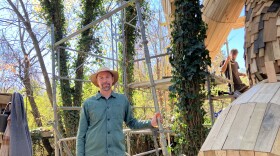Old growth trees in the Pisgah-Nantahala National Forests are significant for several ecological reasons. Some environmental advocates say these trees in western North Carolina are not protected enough under a new federal land management plan.
"We will continue to fight to protect these last remaining old growth forests in the special places on the Pisgah and Nantahala National Forests," said Patrick Hunter, attorney at the Southern Environmental Law Center (SELC).
Old growth forests provide numerous benefits, including wildlife habitat, carbon sequestration, and air and water filtration.
"The forest here in western North Carolina is where the drinking water supply originates for huge numbers of people throughout the southeast," said Susannah Knox, also with SELC. "But [old growth trees also] mitigate flood, landslide, and fire risk. They're more resilient all kinds of natural disasters."
These forests are increasingly rare. Since concerted logging began in the United States, estimates suggest that less than one percent of old growth trees remain along the East Coast.
"It's really important that we preserve the few remaining patches of old growth that we have left, and then allow our older forests... to develop into old growth conditions," said Hunter.
This past February, the U.S. Forest Service published a new land management plan that sets goals and guidelines for how to protect and use the Pisgah-Nantahala Forests.
The plan creates a so-called "old growth network." The network designates parts of the forests to be preserved with the idea that these areas will evolve to become old growth. But Hunter says this plan will also allow logging of trees that are already old growth.
"What they’re doing is putting real old growth on the chopping block, while preserving forests, frankly, that they have no intention of logging," Hunter said.
The Forest Service denied WUNC's request for an interview. In an emailed statement, spokesman Alan Abernethy argues the revised plan will actually increase the amount of land managed for old growth.
"The revised plan makes the biggest commitment to old growth since 1994, increasing the designated old growth network to about 25 percent of the forest where the Forest Service will work to ensure the development of old growth characteristics," Abernethy said via email. "In addition to the 265,000-acre designated old growth network, hundreds of thousands of acres of forest outside the network will continue to age and progress to old growth conditions over time."
The Forest Service last revised its land management plan in 1994.
SELC is considering different options, including legal actions, against the Forest Service. Meanwhile, other advocates are taking a different approach.
A coalition of grassroots activists has been trying for years to get part of the Pisgah National Forest federally protected as a national scenic area.
"[This area] is a biological and recreational treasure," said Will Harlan with the Center for Biological Diversity.
The proposed Craggy National Scenic Area includes 16,000 acres and would help preserve old growth trees that Harlan says are endangered under the new land management plan.
The proposal needs to be passed by Congress. Harlan says it has broad bipartisan support from local and national leaders.
"We think it’s only a matter of time before it gets permanently protected and designated as North Carolina’s very first national scenic area," said Harlan.
Harlan also points to other federal efforts by the Biden administration to conserve old growth.
Last April, President Biden ordered the U.S. Forest Service and the Bureau of Land Management to take an inventory of mature and old growth forests on federally managed lands. The inventory found that old growth forest represents approximately 18 percent of all forested land managed by the two agencies.
Now the administration is seeking public feedback on national policies to protect old growth forests. Public comment is open until July 20.















